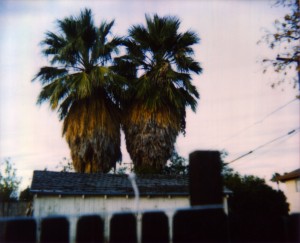If it were up to the Phoenix Motion Picture Office, there would be no palm trees in the city.
The reason? Production companies travel to Phoenix to film and photograph in great weather, many times trying to replicate another place, like Canada or the Midwest. For every wonderful East Coast-looking home they find, chances are there’s a palm tree in the background.
Palms in the Valley are ubiquitous. Though they’re not truly native to the city, the palm tree Washingtonia filifera, which we all know from the misnomer “California Fan Palm” are actually native to at least two areas of the state: Palm Canyon in the Kofa (“King of Arizona”) Mountains and Castle Creek in Yavapai County.
In the case of Palm Canyon, it’s an 18-mile drive south of Quartzsite on Arizona 95, with an eight mile graded yet rough road to the entrance to Palm Canyon. Hiking into the canyon rewards with a view to Arizona’s subtropical history, as the palms line the floor and perch high above on the canyon walls. You would expect a mastodon to pop his head between the fronds, as the palms are truly remnants of the 25 million years ago Miocene and Pliocene epoch.
The palms of Castle Creek, however, were probably responsible for the first described native Western fan palm. The information, though sketchy, describes purple seed pods discovered from a stagecoach trip along the old route between Prescott and Wickenburg, with Castle Creek passed along the way.
Given these Arizona seeds in 1879, the German botanist Hermann Von Wendland skillfully raised them in his Belgium nursery. He described them as different than the previously catalogued Palmae Brahea or Pritchardia filifera, and named this new fan palm Washingtonia filifera in honor of our nation’s first President, a man Wendland admired.
The Valley mimics the desert homes of other palm varieties as well. The tall and spindly Mexican Fan Palm (Washingtonia robusta) towers over its more diminutive cousins on many Valley streets, and there are examples of Mediterranean fan palms (Chamaerops humilis) in places like the park just North of 15th Avenue and McDowell. Look for the plant with a body like Cleopatra of The Addam’s Family fame and you’ll see it.
For those fortunate and protective enough to raise them, the familiar date palm (Phoenix dactylifera) produces luscious Medjool date fruits. Brought from the Middle East in the 19th century, date farms existed in the Mesa and Tempe area, though they were not without their problems.
The Roosevelt Salt River Valley Book, an 1899 promotional publication for Valley agriculture, states “While the deserts of the Old World and our own Southwest resemble each other in a general way, they are not identical, and imported trees find themselves confronted by modification in climate, by new insect and animal enemies and by changed commercial conditions.”
The article goes on to more optimistic forecasts for the area’s ostrich farming, with one ranch raising 3500 birds to feather the lady’s hats of the period.
Though date farming declined by the 1930’s, ideas are currently discussed to use date palms for productive and shady groves in unused land downtown. An idea proposed by Rob Merrill in ASU associate professor Nan Ellin’s 2007 presentation, “Creating a ‘There’ Here” proposes date palm groves in land-banked empty lots. Citing low water use, cheap plants and little more equipment than a ladder required for harvest, Merrill envisions a Downtown Date Festival with on-site marketing of the brown sugary jewels.
As far-fetched as this sounds, it may just be easier to give your date palm a little more water, watch for when the seeds begin to brown and plump and use a nice long stick to give them a knock down. Right off the tree, taste their sweetness, and let your mind wander to a desert oasis with swaying palms and perhaps a few happy ostriches.
